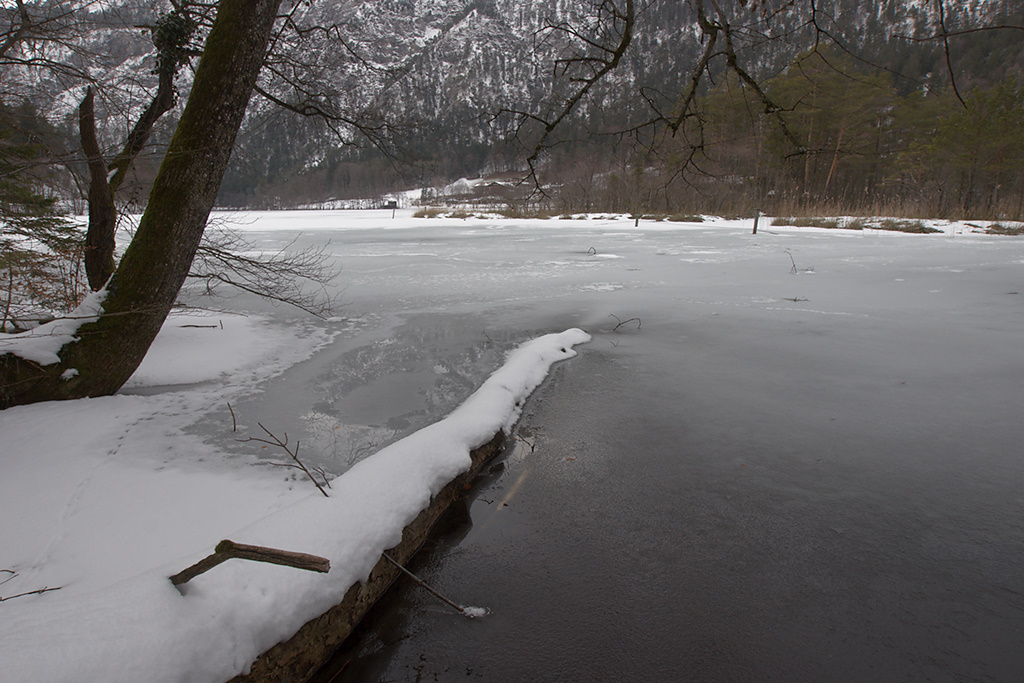

Although the weather indicates the end of ice and snow here – at least of the semi-permanent stuff – I want to share a last image of frozen Thumsee with you. This image create a kind of conflict in me: Usually I restrict myself to very limited operations in postprocessing, kind of the wet darkroom stuff like burning/dodging, contrast operations etc. But here the linear shape of that fallen tree was disturbed by a branch sticking out in the foreground. Without it I like the image much better, so I removed it. But this of course is a critical operation: without limits I might transplant items in the next image, or between images, and I don’t know where this would end. I guess I will stick with my old rule: If I could have removed it by hand, I can clone it out. Just sometimes a little bending of the rules…
Marcus, I couldn’t disagree more. The picture with the wonderful crooked branch in the snow is much more complex and interesting.
Maybe that’s why I don’t spend any time worrying about these issues. The picture works or it doesn’t. If it doesn’t, ignore it. Make another. If it works, good.
Time spent studying our pictures to try to understand where we’re going is time well spent. Time spent “retouching”—trying to turn them into something that wasn’t there to be seen—is usually time wasted.
I believe it’s up to the individual photographer to make decisions as to what or how much effort they want to expend in post-processing. Photography is an individual journey, not a group journey, and therefore we’re each free to follow our own path. The best advice is to please yourself and not to worry about the opinion of others.
I also believe while everyone is entitled to their own opinions no one is entitled to expressed their opinions as if they are some higher law of truth. Wasted time for one may be value added to another.
By the way, personally I like it better without the branch. Beautiful photo!
Carl, Earl: Thanks for your (diverging) opinions. The two versions of the image for sure do resonate with different persons, and your spontaneous disagreement, Carl, for sure got me thinking. I guess I will get prints from both versions, just to learn from the discussions.
The decision to modify the image in a central element of the original was not taken with levity as I personally am convinced that in photography, other than painting, the things that are belong to the image and are not subject to free disposal of the photographer. This originally caused my already ambigous feelings about the final processed image. And thinking back about my own (negative) reaction learning about the practice of one of our postcard photographers to, for example, augment the height of the mountains by 10%, I now think that it might have been better to abstain from such a modification of my image.
In any case I am grateful for your comments and opinions. Discussions live from dissent, and from exposure to different points of view at least I do learn and improve.
Earl, that’s why I said “usually.” Everyone should indeed find their own way. But I see a lot more photographs that don’t work well because the photographer did too much, than because they weren’t post-processed enough.
Markus, that’s weird about the postcards and exaggerated mountains. I guess people don’t expect postcard photographers to adhere to journalistic ethical practices, but still. I also wonder about the motivation. Is the exaggeration the direct aim—some sort of boosterism—or is it a competitive move? Do the exaggerated mountains sell more than a competitor’s unaltered views? It would be interesting to know.
Carl, I did ask, and the answer was “that the customers like it”. There is no direct competition in form of other photographers, but maybe the unsaid wish to present the home country in the most interesting way, competing with other alpine regions that do have higher mountains.
Carl, sorry, I didn’t mean to come over so hard-nosed. I view post-processing as a means of further studying a photo to determine why it works or doesn’t work, but I don’t believe in major revisions of photos. I certainly agree there are numerous examples of over processing but if bad results were a reason to stop exploring I would never have gotten past my beginner phase of photography. 🙂
Earl, many years before digital, the great photographer/writer/teacher David Vestal pointed out that often the only way to find out if a picture is any good is to try to print it. If you get a good print, it’s a good picture. If not… 😉 Post-processing is basically the analog of printing in the traditional darkroom. People tended to over-manipulate darkroom prints, too.
It’s not that I’m against all manipulation either. I used to do burning and dodging in the silver darkroom all the time (almost never needed printing in platinum). I find it less needed in digital printing than silver because the digital global controls are so powerful and delicate. But just this morning I spent a good half hour carefully painting in a burn layer for a tiny portion of a picture. Background bright area was drawing attention from more important stuff in the foreground, ruining the conveyance of my initial visual impression of the scene. Local manipulation was needed to restore the picture to my original subjective understanding.